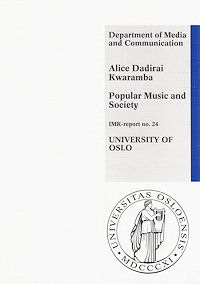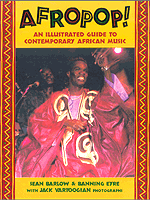kwaramba1997
|
Kwaramba, Alice Dadirai: |
 CONTENTS
CONTENTS
Preface
Acknowledgements
Chapter 1
Introduction 1
1.1 Background 1
1.1.2 Statement of the Problem and Limitations 6
1.1.3 Justification 8
1.2 Theoretical Foundations and Conceptual Framework 10
1.2.1 Theoretical Foundations 10
1.2.1.1 Literary Theory and Analysis of Songs 11
1.2.1.2 Critical Language Analysis 12
1.2.2 Conceptual Framework 14
1.2.2.1 Language 14
1.2.2.2 Discourse 15
1.2.2.3 Ideology 16
1.2.2.4 Songs as Texts 17
1.2.2.5 Meaning in Texts 18
1.2.2.6 Popular Music 20
1.2.2.7 ‘The People’ 22
1.3 Analytical Technique 23
1.3.1 Towards a Framework for the Analysis of Songs 23
1.3.2 Analytical Procedure 24
1.3.2.1 Content Analysis 24
1.3.2.2 Procedure 25
1.3.3 Historical Time Frame 26
1.3.4 Selection of Songs 27
1.3.5 Methodological Limitations 28
1.4 The Discography 28
1.5 A Note on Translation 29
Chapter 2
Protest and Confrontation: “Tumirai Vana Kuhando!”
(Send Your Children to War!) 31
2.1 Background 31
2.2 Analysis of Song Texts 35
2.2.1 Lexical Selection 38
2.2.1.1 Titles 39
2.2.1.2 Synonyms and Over-lexicalisation 40
2.2.1.3 Lexical Ambiguity 41
2.2.2 Syntactic Patterns 42
2.2.2.1 Grammatical Mood of Verbs 43
2.2.2.2 Cataloguing 49
2.2.2.3 Agency 50
2.2.2.4 Presupposition 51
2.2.3 Use of Culture Specific Expressions, Symbols
and Metaphors 53
2.2.3.1 Proverbs 54
2.2.3.2 Idiomatic Expressions and
Customary Beliefs 54
2.2.3.3 Metaphor 55
2.2.3.4 Folkloric and Traditional Genres 58
2.2.3.5 Transposition of War and
Hunting Songs 58
2.2.4 Marked Pronouns as Key Actors 61
2.2.4.1 ‘You’ versus’Us’ 61
2.2.4.2 The Pronoun ‘We’ 62
2.2.5 Extra-Linguistic Features 63
2.2.5.1 Attire 63
2.2.5.2 Beat, Pace and Choice of Instruments 64
2.2.6 The Medium of Expression 65
2.2.7 Conclusion 67
Chapter 3
From Protest to Celebration and Consolidation:
“Tirikupemberera Zimbabwe” (We are Celebrating
the Birth of Zimbabwe) 69
3.1 Background 69
3.2 Analysis of Song Texts 74
3.2.1 Lexical Selection 78
3.2.1.1 Titles 79
3.2.1.2 Synonyms and Overlexicalisation 79
3.2.1.3 Ambiguity and Vagueness Disappear 80
3.2.1.4 Intertextuality 81
3.2.2 Syntactic Patterns 82
3.2.2.1 Grammatical Mood 82
3.2.2.2 Cataloguing 89
3.2.3 Statement of Participants, Agency, Causality
and Responsibility 90
3.2.4 Use of Marked Pronouns 93
3.2.4.1 The Pronoun ‘We’ is Redefined 94
3.2.5 From Culture Specific to ‘Universal’ Symbols
and Metaphors 99
3.2.5.1 Metaphors and Symbols 99
3.3 Extra-Linguistic Features 100
3.3.1 Attire 100
3.3.2 Instrumentation 102
3.3.3 Pace and Form of Music 103
3.4 Medium of Expression 103
3.5 Conclusion 104
Chapter 4
From Celebration back to Protest:
‘Vakuru Vepano Matadza Kutonga!’
(Gentleman, You’ve Failed to Rule!) 107
4.1 Background 107
4.2 Analysis of Song Texts 112
4.2.1 Lexical Selection 114
4.2.1.1 Title 114
4.2.1.2 Synonymy and Overlexicalisation 115
4.2.2 Syntactic Patterns 115
4.2.2.1 Grammatical Mood 115
4.2.3 Use of Pronouns 120
4.2.3.1 ‘Them and ‘Us’ Division Re-emerges
and is Redefined 120
4.2.3.2 The Pronoun ‘We’ is Redefined 124
4.3 Extra-Linguistic Features 138
4.3.1 Attire 138
4.3.2 Pace and Form of The Music 139
4.4 Medium of Expression 140
4.5 Conclusion 140
Chapter 5
Observations and Concluding Reflections 143
5.1 Observations 143
5.1.2 Changing Patterns in Discourse 144
5.1.3 The Covert-Overt Poles 145
5.1.4 The Pronoun ‘We’ 147
5.1.5 Social Identities 148
5.1.6 Ideological Contestation 149
5.1.7 Extra-linguistic Features 150
5.1.8 Choice of Medium of Expression 152
5.2 Concluding Reflections 154
Notes 157
Discography 161
Bibliography 171


 CONTENTS
CONTENTS CONTENTS
CONTENTS INHALT (Button Type)
INHALT (Button Type) CONTENTS
CONTENTS